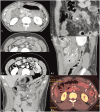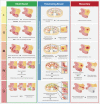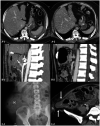Radiologic Imaging of Traumatic Bowel and Mesenteric Injuries: A Comprehensive Up-to-Date Review
- PMID: 37133211
- PMCID: PMC10157329
- DOI: 10.3348/kjr.2022.0998
Radiologic Imaging of Traumatic Bowel and Mesenteric Injuries: A Comprehensive Up-to-Date Review
Abstract
Diagnosing bowel and mesenteric trauma poses a significant challenge to radiologists. Although these injuries are relatively rare, immediate laparotomy may be indicated when they occur. Delayed diagnosis and treatment are associated with increased morbidity and mortality; therefore, timely and accurate management is essential. Additionally, employing strategies to differentiate between major injuries requiring surgical intervention and minor injuries considered manageable via non-operative management is important. Bowel and mesenteric injuries are among the most frequently overlooked injuries on trauma abdominal computed tomography (CT), with up to 40% of confirmed surgical bowel and mesenteric injuries not reported prior to operative treatment. This high percentage of falsely negative preoperative diagnoses may be due to several factors, including the relative rarity of these injuries, subtle and non-specific appearances on CT, and limited awareness of the injuries among radiologists. To improve the awareness and diagnosis of bowel and mesenteric injuries, this article provides an overview of the injuries most often encountered, imaging evaluation, CT appearances, and diagnostic pearls and pitfalls. Enhanced diagnostic imaging awareness will improve the preoperative diagnostic yield, which will save time, money, and lives.
Keywords: GI tract; Injuries; Mesentery; Radiologists; Tomography, X-Ray computed.
Copyright © 2023 The Korean Society of Radiology.
Conflict of interest statement
The authors have no potential conflicts of interest to disclose.
Figures










References
-
- Lawson CM, Daley BJ, Ormsby CB, Enderson B. Missed injuries in the era of the trauma scan. J Trauma. 2011;70:452–456. discussion 456-8. - PubMed
-
- Landry BA, Patlas MN, Faidi S, Coates A, Nicolaou S. Are we missing traumatic bowel and mesenteric injuries? Can Assoc Radiol J. 2016;67:420–425. - PubMed
-
- Watts DD, Fakhry SM EAST Multi-Institutional Hollow Viscus Injury Research Group. Incidence of hollow viscus injury in blunt trauma: an analysis from 275,557 trauma admissions from the East multi-institutional trial. J Trauma. 2003;54:289–294. - PubMed
Publication types
MeSH terms
LinkOut - more resources
Full Text Sources

